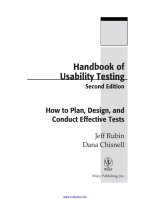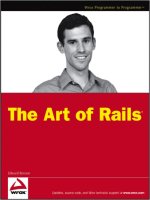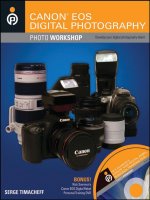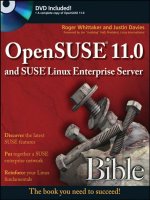Wiley handbook of usability testing howto plan design and conduct effective tests 2nd edition may 2008 ISBN 0470185481 pdf
Bạn đang xem bản rút gọn của tài liệu. Xem và tải ngay bản đầy đủ của tài liệu tại đây (1.31 MB, 386 trang )
Handbook of
Usability Testing
Handbook of
Usability Testing
Second Edition
How to Plan, Design, and
Conduct Effective Tests
Jeff Rubin
Dana Chisnell
Wiley Publishing, Inc.
Handbook of Usability Testing, Second Edition: How to Plan, Design, and Conduct
Effective Tests
Published by
Wiley Publishing, Inc.
10475 Crosspoint Boulevard
Indianapolis, IN 46256
Copyright 2008 by Wiley Publishing, Inc., Indianapolis, Indiana
Published simultaneously in Canada
ISBN: 978-0-470-18548-3
Manufactured in the United States of America
10 9 8 7 6 5 4 3 2 1
No part of this publication may be reproduced, stored in a retrieval system or transmitted
in any form or by any means, electronic, mechanical, photocopying, recording, scanning or
otherwise, except as permitted under Sections 107 or 108 of the 1976 United States Copyright
Act, without either the prior written permission of the Publisher, or authorization through
payment of the appropriate per-copy fee to the Copyright Clearance Center, 222 Rosewood
Drive, Danvers, MA 01923, (978) 750-8400, fax (978) 646-8600. Requests to the Publisher
for permission should be addressed to the Legal Department, Wiley Publishing, Inc., 10475
Crosspoint Blvd., Indianapolis, IN 46256, (317) 572-3447, fax (317) 572-4355, or online at
/>Limit of Liability/Disclaimer of Warranty: The publisher and the author make no representations or warranties with respect to the accuracy or completeness of the contents of
this work and specifically disclaim all warranties, including without limitation warranties
of fitness for a particular purpose. No warranty may be created or extended by sales or
promotional materials. The advice and strategies contained herein may not be suitable for
every situation. This work is sold with the understanding that the publisher is not engaged
in rendering legal, accounting, or other professional services. If professional assistance is
required, the services of a competent professional person should be sought. Neither the
publisher nor the author shall be liable for damages arising herefrom. The fact that an
organization or Website is referred to in this work as a citation and/or a potential source of
further information does not mean that the author or the publisher endorses the information the organization or Website may provide or recommendations it may make. Further,
readers should be aware that Internet Websites listed in this work may have changed or
disappeared between when this work was written and when it is read.
For general information on our other products and services or to obtain technical support,
please contact our Customer Care Department within the U.S. at (800) 762-2974, outside the
U.S. at (317) 572-3993 or fax (317) 572-4002.
Library of Congress Cataloging-in-Publication Data is available from the publisher.
Trademarks: Wiley, the Wiley logo, and related trade dress are trademarks or registered
trademarks of John Wiley & Sons, Inc. and/or its affiliates, in the United States and other
countries, and may not be used without written permission. All other trademarks are
the property of their respective owners. Wiley Publishing, Inc. is not associated with any
product or vendor mentioned in this book.
Wiley also publishes its books in a variety of electronic formats. Some content that appears
in print may not be available in electronic books.
Dedicated to those for whom usability and user-centered design
is a way of life and their work a joyful expression of their
genuine concern for others.
— Jeff
To my parents, Jan and Duane Chisnell, who believe me
when I tell them that I am working for world peace through user
research and usability testing.
— Dana
About the Authors
Jeff Rubin has more than 30 years experience as a human factors/usability
specialist in the technology arena. While at the Bell Laboratories’ Human Performance Technology Center, he developed and refined testing methodologies,
and conducted research on the usability criteria of software, documentation,
and training materials.
During his career, Jeff has provided consulting services and workshops on
the planning, design, and evaluation of computer-based products and services
for hundreds of companies including Hewlett Packard, Citigroup, Texas
Instruments, AT&T, the Ford Motor Company, FedEx, Arbitron, Sprint, and
State Farm. He was cofounder and managing partner of The Usability Group
from 1999–2005, a leading usability consulting firm that offered user-centered
design and technology adoption strategies. Jeff served on the Board of the
Usability Professionals Association from 1999–2001.
Jeff holds a degree in Experimental Psychology from Lehigh University. His
extensive experience in the application of user-centered design principles to
customer research, along with his ability to communicate complex principles
and techniques in nontechnical language, make him especially qualified to
write on the subject of usability testing.
He is currently retired from usability consulting and pursuing other passionate interests in the nonprofit sector.
Dana Chisnell is an independent usability consultant and user researcher
operating UsabilityWorks in San Francisco, CA. She has been doing usability
research, user interface design, and technical communications consulting and
development since 1982.
Dana took part in her first usability test in 1983, while she was working as
a research assistant at the Document Design Center. It was on a mainframe
office system developed by IBM. She was still very wet behind the ears. Since
vii
viii
About the Authors
then, she has worked with hundreds of study participants for dozens of clients
to learn about design issues in software, hardware, web sites, online services,
games, and ballots (and probably other things that are better forgotten about).
She has helped companies like Yahoo!, Intuit, AARP, Wells Fargo, E*TRADE,
Sun Microsystems, and RLG (now OCLC) perform usability tests and other
user research to inform and improve the designs of their products and services.
Dana’s colleagues consider her an expert in usability issues for older adults
and plain language. (She says she’s still learning.) Lately, she has been working
on issues related to ballot design and usability and accessibility in voting.
She has a bachelor’s degree in English from Michigan State University. She
lives in the best neighborhood in the best city in the world.
Credits
Executive Editor
Bob Elliott
Development Editor
Maureen Spears
Technical Editor
Janice James
Production Editor
Eric Charbonneau
Copy Editor
Foxxe Editorial Services
Editorial Manager
Mary Beth Wakefield
Production Manager
Tim Tate
Vice President and Executive
Group Publisher
Richard Swadley
Vice President and Executive
Publisher
Joseph B. Wikert
Project Coordinator, Cover
Lynsey Stanford
Proofreader
Nancy Bell
Indexer
Jack Lewis
Cover Image
Getty Images/Photodisc/
McMillan Digital Art
ix
Acknowledgments
From Jeff Rubin
From the first edition, I would like to acknowledge:
Dean Vitello and Roberta Cross, who edited the entire first manuscript.
Michele Baliestero, administrative assistant extraordinaire.
John Wilkinson, who reviewed the original outline and several chapters
of the manuscript.
Pamela Adams, who reviewed the original outline and most of the
manuscript, and with whom I worked on several usability projects.
Terri Hudson from Wiley, who initially suggested I write a book on this
topic.
Ellen Mason, who brought me into Hewlett Packard to implement a
user-centered design initiative and allowed me to try out new research
protocols.
For this second edition, I would like to acknowledge:
Dave Rinehart, my partner in crime at The Usability Group, and codeveloper of many user research strategies.
The staff of The Usability Group, especially to Ann Wanschura, who was
always loyal and kind, and who never met a screener questionnaire she
could not master.
Last, thanks to all the clients down through the years who showed confidence and trust in me and my colleagues to do the right thing for their
customers.
xi
xii
Acknowledgments
From Dana Chisnell
The obvious person to thank first is Jeff Rubin. Jeff wrote Handbook of Usability
Testing, one of the seminal books about usability testing, at a time when it
was very unusual for companies to invest resources in performing a reality
check on the usability of their products. The first edition had staying power. It
became such a classic that apparently people want more. For better or worse,
the world still needs books about usability testing. So, a thousand thank-yous
to Jeff for writing the first edition, which helped many of us get started with
usability testing over the last 14 years. Thanks, too, Jeff, for inviting me to
work with you on the second edition. I am truly honored. And thank you for
offering your patience, diligence, humor, and great wisdom to me and to the
project of updating the Handbook.
Ginny Redish and Joe Dumas deserve great thanks as well. Their book, A
Practical Guide to Usability Testing, which came out at the same time as Jeff’s
book, formed my approach to usability testing. Ginny has been my mentor for
several years. In some weird twist of fate, it was Ginny who suggested me to
Jeff. The circle is complete.
A lot of people will be thankful that this edition is done, none of them more
than I. But Janice James probably comes a close second. Her excellent technical
review of every last word of the second edition kept Jeff and me honest on
the methodology and the modern realities of conducting usability tests. She
inspired dozens of important updates and expansions in this edition.
So did friends and colleagues who gave us feedback on the first edition to
inform the new one. JoAnn Hackos, Linda Urban, and Susan Becker all gave
detailed comments about where they felt the usability world had changed,
what their students had said would be more helpful, and insights about what
they might do differently if it were their book.
Arnold Arcolio, who also gave extensive, specific comments before the
revising started, generously spot-checked and re-reviewed drafts as the new
edition took form.
Sandra Olson deserves thanks for helping me to develop a basic philosophy
about how to recruit participants for user research and usability studies. Her
excellent work as a recruiting consultant and her close review informed much
that is new about recruiting in this book.
Ken Kellogg, Neil Fitzgerald, Christy Wells, and Tim Kiernan helped me
understand what it takes to implement programs within companies that
include usability testing and that attend closely to their users’ experiences.
Other colleagues have been generous with stories, sources, answers to
random questions, and examples (which you will see sprinkled throughout
the book), as well. Chief among them are my former workmates at Tec-Ed,
especially Stephanie Rosenbaum, Laurie Kantner, and Lori Anschuetz.
Acknowledgments
Jared Spool of UIE has also been encouraging and supportive throughout,
starting with thorough, thoughtful feedback about the first edition and continuing through liberal permissions to include techniques and examples from
his company’s research practice in the second edition.
Thanks also go to those I’ve learned from over the years who are part of the
larger user experience and usability community, including some I have never
met face to face but know through online discussions, papers, articles, reports,
and books.
To the clients and companies I have worked with over 25 years, as well as the
hundreds of study participants, I also owe thanks. Some of the examples and
stories here reflect composites of my experiences with all of those important
people.
Thanks also go to Bob Elliott at Wiley for contacting Jeff about reviving the Handbook in the first place, and Maureen Spears for managing the
‘‘developmental’’ edit of a time-tested resource with humor, flexibility, and
understanding.
Finally, I thank my friends and family for nodding politely and pouring
me a drink when I might have gone over the top on some point of usability
esoterica (to them) at the dinner table. My parents, Jan and Duane Chisnell,
and Doris Ditner deserve special thanks for giving me time and space so I
could hole up and write.
xiii
Contents
Acknowledgments
Foreword
xi
xxix
Preface to the Second Edition
Part One
Usability Testing: An Overview
Chapter 1
What Makes Something Usable?
What Do We Mean by ‘‘Usable’’?
What Makes Something Less Usable?
Five Reasons Why Products Are Hard to Use
Reason 1: Development Focuses on the Machine or System
Reason 2: Target Audiences Expand and Adapt
Reason 3: Designing Usable Products Is Difficult
Reason 4: Team Specialists Don’t Always Work in
Integrated Ways
Reason 5: Design and Implementation Don’t Always
Match
What Makes Products More Usable?
An Early Focus on Users and Tasks
Evaluation and Measurement of Product Usage
Iterative Design and Testing
Attributes of Organizations That Practice UCD
Phases That Include User Input
A Multidisciplinary Team Approach
Concerned, Enlightened Management
A ‘‘Learn as You Go’’ Perspective
Defined Usability Goals and Objectives
xxxiii
3
4
6
6
7
8
9
9
11
12
13
13
14
14
14
14
15
15
16
xv
xvi
Contents
What Are Techniques for Building in Usability?
Ethnographic Research
Participatory Design
Focus Group Research
Surveys
Walk-Throughs
Open and Closed Card Sorting
Paper Prototyping
Expert or Heuristic Evaluations
Usability Testing
Follow-Up Studies
16
16
17
17
17
18
18
18
19
19
20
Chapter 2
What Is Usability Testing?
Why Test? Goals of Testing
Informing Design
Eliminating Design Problems and Frustration
Improving Profitability
Basics of the Methodology
Basic Elements of Usability Testing
Limitations of Testing
21
21
22
22
22
23
25
25
Chapter 3
When Should You Test?
Our Types of Tests: An Overview
Exploratory or Formative Study
When
Objective
Overview of the Methodology
Example of Exploratory Study
Assessment or Summative Test
When
Objective
Overview of the Methodology
Validation or Verification Test
When
Objective
Overview of the Methodology
Comparison Test
When
Objective
Overview of the Methodology
Iterative Testing: Test Types through the Lifecycle
Test 1: Exploratory/Comparison Test
The situation
Main Research Questions
27
27
29
29
29
30
32
34
34
34
35
35
35
35
36
37
37
37
38
39
39
39
40
Contents
Brief Summary of Outcome
Test 2: Assessment Test
The Situation
Main Test Objectives
Brief Summary of Test Outcome
Test 3: Verification Test
The Situation
Test Objectives
Brief Summary of Test Outcome
Chapter 4
Skills for Test Moderators
Who Should Moderate?
Human Factors Specialist
Marketing Specialist
Technical Communicator
Rotating Team Members
External Consultant
Characteristics of a Good Test Moderator
Grounding in the Basics of User-Centered Design
Quick Learner
Instant Rapport with Participants
Excellent Memory
Good Listener
Comfortable with Ambiguity
Flexibility
Long Attention Span
Empathic ‘‘People Person’’
‘‘Big Picture’’ Thinker
Good Communicator
Good Organizer and Coordinator
Getting the Most out of Your Participants
Choose the Right Format
Sit-By Sessions versus Observing from Elsewhere
‘‘Think-Aloud’’ Advantages and Disadvantages
Retrospective Review
Give Participants Time to Work through Hindrances
Offer Appropriate Encouragement
Troubleshooting Typical Moderating Problems
Leading Rather than Enabling
Too Involved with the Act of Data Collection
Acting Too Knowledgeable
Too Rigid with the Test Plan
Not Relating Well to Each Participant
41
41
41
41
42
42
42
43
43
45
45
46
46
47
47
47
48
48
48
49
49
49
50
50
51
51
51
52
52
52
53
53
54
54
55
55
56
57
57
57
58
58
xvii
xviii Contents
Jumping to Conclusions
How to Improve Your Session-Moderating Skills
Learn the Basic Principles of Human Factors/Ergonomics
Learn from Watching Others
Watch Yourself on Tape
Work with a Mentor
Practice Moderating Sessions
Learn to Meditate
Practice ‘‘Bare Attention’’
Part Two
The Process for Conducting a Test
Chapter 5
Develop the Test Plan
Why Create a Test Plan?
It Serves as a Blueprint for the Test
It Serves as the Main Communication Vehicle
It Defines or Implies Required Resources
It Provides a Focal Point for the Test and a Milestone
The Parts of a Test Plan
Review the Purpose and Goals of the Test
When Not to Test
Good Reasons to Test
Communicate Research Questions
Summarize Participant Characteristics
Describe the Method
Independent Groups Design or Between Subjects Design
Within-Subjects Design
Testing Multiple Product Versions
Testing Multiple User Groups
List the Tasks
Parts of a Task for the Test Plan
Tips for Developing the Task List
Example Task: Navigation Tab on a Web Site
Ways to Prioritize Tasks
Describe the Test Environment, Equipment, and Logistics
Explain What the Moderator Will Do
List the Data You Will Collect
Sample Performance Measures
Qualitative Data
Sample Preference Measures
Describe How the Results Will Be Reported
Sample Test Plan
58
58
59
59
59
59
60
60
61
65
65
66
66
66
66
67
67
68
69
69
72
73
75
75
76
77
79
79
82
83
85
87
87
88
88
90
90
90
91
Contents
Chapter 6
Chapter 7
Set Up a Testing Environment
Decide on a Location and Space
In a Lab or at the User’s Site?
Test in Multiple Geographic Locations?
Arranging Sessions at a User’s Site
Minimalist Portable Test Lab
Setting up a Permanent or Fixed Test Lab
Simple Single-Room Setup
Modified Single-Room Setup
Large Single-Room Setup
Electronic Observation Room Setup
Classic Testing Laboratory Setup
Recommended Testing Environment: Minimalist
Portable Lab
Gather and Check Equipment, Artifacts, and Tools
Basic Equipment, Tools, and Props
Gathering Biometric Data
Identify Co-Researchers, Assistants, and Observers
Data Gatherer/Note Taker
Timekeeper
Product/Technical Expert(s)
Additional Testing Roles
Test Observers
93
94
94
96
98
100
101
101
103
105
107
108
110
111
111
112
112
112
113
113
113
113
Find and Select Participants
Characterize Users
Visualize the Test Participant
Differentiate between Purchaser and End User
Look for Information about Users
Requirements and Specification Documents
Structured Analyses or Marketing Studies
Product Manager (R&D)
Product Manager (Marketing)
Competitive Benchmarking and Analysis Group
Define the Criteria for Each User Group
Define Expertise
Specify Requirements and Classifiers for Selection
Document the User Profile
Divide the User Profile into Distinct Categories
Consider a Matrix Test Design
Determine the Number of Participants to Test
Write the Screening Questionnaire
115
115
116
116
117
117
118
118
118
119
119
119
121
122
124
125
125
126
xix
xx
Contents
Review the Profile to Understand Users’ Backgrounds
Identify Specific Selection Criteria
Formulate Screening Questions
Organize the Questions in a Specific Order
Develop a Format for Easy Flow through the Questionnaire
Test the Questionnaire on Colleagues and Revise It
Consider Creating an ‘‘Answer Sheet’’
Find Sources of Participants
Internal Participants
Qualified Friends and Family
Web Site Sign-Up
Existing Customers from In-House Lists
Existing Customers through Sales Representatives
User Groups or Clubs, Churches, or Other Community
Groups
Societies and Associations
Referrals from Personal Networks, Coworkers, and Other
Participants
Craigslist
College Campuses
Market Research Firms or Recruiting Specialists
Employment Agencies
Newspaper Advertisements
Screen and Select Participants
Screening Considerations
Use the Questionnaire or Open-Ended Interview
Questions?
Complete the Screener Always, or Only When Fully
Qualified?
Conduct Screening Interviews
Inform the Potential Participant Who You Are
Explain Why You are Calling and How You Got the
Contact Information
Go through the Questions in the Questionnaire
As You Eliminate or Accept People, Mark Them Off on
Your List
Include a Few Least Competent Users in Every Testing
Sample
Beware of Inadvertently Testing Only the ‘‘Best’’ People
Expect to Make Tradeoffs
Schedule and Confirm Participants
127
127
128
129
130
131
131
131
132
134
134
135
136
136
137
137
138
139
140
141
142
143
143
143
144
145
145
145
145
146
146
147
148
148
Contents
Chapter 8
Compensate Participants
Protect Participants’ Privacy and Personal Information
150
151
Prepare Test Materials
Guidelines for Observers
Orientation Script
Keep the Tone of the Script Professional, but Friendly
Keep the Speech Short
Plan to Read the Script to Each Participant Verbatim
Write the Orientation Script Out
Make Introductions
Offer Refreshments
Explain Why the Participant Is Here
Describe the Testing Setup
Explain What Is Expected of the Participant
Assure the Participant That He or She Is Not Being Tested
Explain Any Unusual Requirements
Mention That It Is Okay to Ask Questions at Any Time
Ask for Any Questions
Refer to Any Forms That Need Be Completed and Pass
Them Out
Background Questionnaire
Focus on Characteristics That May Influence Performance
Make the Questionnaire Easy to Fill Out and Compile
Test the Questionnaire
Decide How to Administer the Questionnaire
Data Collection Tools
Review the Research Question(s) Outlined in Your Test Plan
Decide What Type of Information to Collect
Select a Data Collection Method
Fully Automated Data Loggers
Online Data Collection
User-Generated Data Collection
Manual Data Collection
Other Data Collection Methods
Nondisclosures, Consent Forms, and Recording Waivers
Pre-Test Questionnaires and Interviews
Discover Attitudes and First Impressions
Learn about Whether Participants Value the Product
Qualify Participants for Inclusion into One Test Group or
Another
153
154
155
156
156
157
158
159
159
159
160
160
161
161
161
161
161
162
163
163
163
163
165
167
167
168
168
169
169
170
170
173
174
175
177
179
xxi
xxii
Contents
Establish the Participant’s Prerequisite Knowledge Prior to
Using the Product
Prototypes or Products to Test
Task Scenarios
Provide Realistic Scenarios, Complete with Motivations to
Perform
Sequence the Task Scenarios in Order
Match the Task Scenarios to the Experience of the Participants
Avoid Using Jargon and Cues
Try to Provide a Substantial Amount of Work in Each
Scenario
Give Participants the Tasks to Do
Reading Task Scenarios to the Participants
Letting the Participants Read Task Scenarios Themselves
Optional Training Materials
Ensure Minimum Expertise
Get a View of the User after Experiencing the Product
You Want to Test Features for Advanced Users
What Are the Benefits of Prerequisite Training?
You Can Conduct a More Comprehensive, Challenging
Usability Test
You Can Test Functionality That Might Otherwise Get
Overlooked During a Test
Developing the Training Forces You to Understand How
Someone Learns to Use Your Product
Some Common Questions about Prerequisite Training
Post-Test Questionnaire
Use the Research Questions(s) from the Test Plan as the Basis
for Your Content
Develop Questionnaires That Will Be Distributed Either
during or after a Session
Ask Questions Related to That Which You Cannot Directly
Observe
Develop the Basic Areas and Topics You Want to Cover
Design the Questions and Responses for Simplicity and
Brevity
Use the Pilot Test to Refine the Questionnaire
Common Question Formats
Likert Scales
Semantic Differentials
Fill-In Questions
181
181
182
183
183
184
184
184
185
185
186
187
187
188
189
190
190
190
191
191
192
193
193
193
195
196
196
197
197
197
198
Contents xxiii
Checkbox Questions
Branching Questions
Chapter 9
198
198
Debriefing Guide
199
Conduct the Test Sessions
Guidelines for Moderating Test Sessions
Moderate the Session Impartially
Be Aware of the Effects of Your Voice and Body Language
Treat Each New Participant as an Individual
If Appropriate, Use the ‘‘Thinking Aloud’’ Technique
Advantages of the ‘‘Thinking Aloud’’ Technique
Disadvantages of the ‘‘Thinking Aloud’’ Technique
How to Enhance the ‘‘Thinking Aloud’’ Technique
Probe and Interact with the Participant as Appropriate
Stay Objective, But Keep the Tone Relaxed
Don’t ‘‘Rescue’’ Participants When They Struggle
If You Make a Mistake, Continue On
Ensure That Participants Are Finished Before Going On
Assist the Participants Only as a Last Resort
When to Assist
How to Assist
Checklists for Getting Ready
Checklist 1: A Week or So Before the Test
Take the Test Yourself
Conduct a Pilot Test
Revise the Product
Check Out All the Equipment and the Testing
Environment
Request a Temporary ‘‘Freeze’’ on Development
Checklist 2: One Day Before the Test
Check that the Video Equipment is Set Up and Ready
Check that the Product, if Software or Hardware, is
Working
Assemble All Written Test Materials
Check on the Status of Your Participants
Double-Check the Test Environment and Equipment
Checklist 3: The Day of the Test
Prepare Yourself Mentally
Greet the Participant
Have the Participant Fill Out and Sign Any Preliminary
Documents
Read the Orientation Script and Set the Stage
201
202
202
203
203
204
204
205
205
206
209
209
210
210
211
211
212
213
214
214
215
215
216
216
216
216
217
217
217
217
217
218
219
220
220









